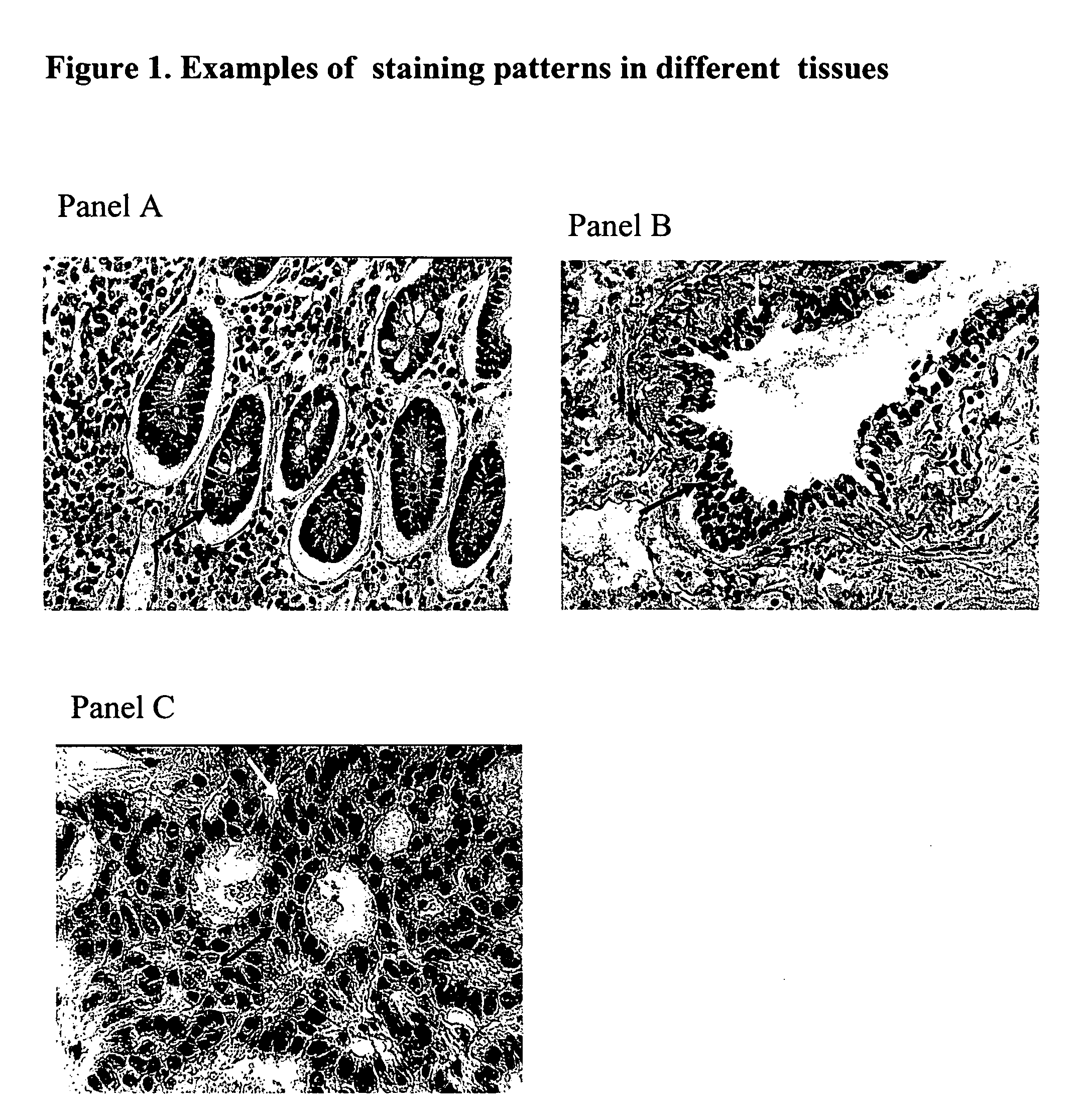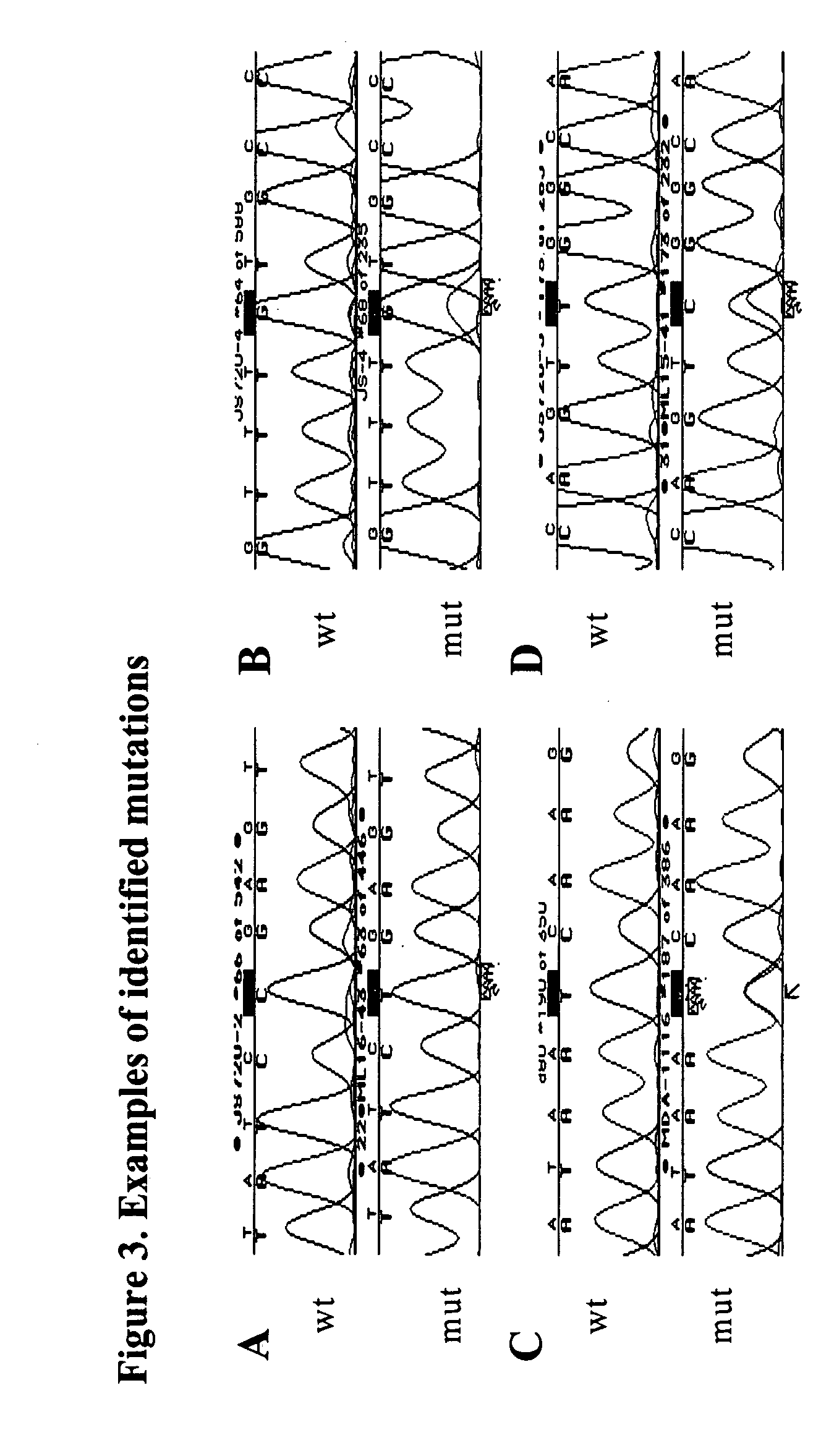Measurement of mutation load using the p53 gene in human cells from paraffin embedded tissues
a technology of paraffin embedded tissues and mutation load, which is applied in the direction of microbiological testing/measurement, biochemistry apparatus and processes, and fermentation, etc., can solve the problems of increasing the risk of cancer or other cellular abnormalities, and achieve the effects of monitoring the effectiveness of cancer therapy, increasing cancer risk, and assessing cancer risk and prognosis
- Summary
- Abstract
- Description
- Claims
- Application Information
AI Technical Summary
Benefits of technology
Problems solved by technology
Method used
Image
Examples
example i
Immunohistochemical Staining and Microdissection
[0029] Fresh tissue from colon cancer patients was cut into 3-4 mm thin slices and immediately transferred into jars with the ethanol-based fixative (95% ethanol with 0.2 mM EDTA buffer, pH 8.0) for at least 12 hrs. The specimens were processed the following day, and paraffin embedded using standard procedures. From each tissue block, sections of 6 μm diameter were cut using a rotation microtome. The deparaffinization process included one xylene step at room temperature for 30 min with shaking every 5 min, followed by steps in alcohols of different concentrations. Stearn heating at 96-100° C. for 5 minutes in 1 mM EDTA buffer (pH 8.0) was performed to unmask the antigenic sites.
[0030] The PCNA antibody (Ab-1 monoclonal mouse IgG antibody) (Oncogene Calbiocaem) was used in a concentration of 1:4000; the p53 antibody (mouse monoclonal antibody DO7) (Novocastra) was used in a concentration of 1:100. The tissue sections were double stain...
example ii
Stimulated PCR
[0033] In order to detect mutations in the single cell chosen for microdissection isolation from the paraffin-embedded tissue, the single cell was subjected to the Stimulated PCR technique. In preparing for the Stimulated-PCR used to amplify the single cell mutations, primer selection is important. Here, all primers were designed and analyzed with Oligo 5 software (National Biosciences). Tm of the primer was estimated by the nearest neighbor method at 50 mM KCl and 250 pM DNA and Tm of the PCR segment was estimated by the formula of Wetinur: Tmproduct=81.5+16.6 log [K+=0.05M]+0.41(% G+% C)−675 / length. Wetmur, J. G., “DNA probes: Applications of the Principles of Nucleic Acid Hybridization”, Critical Rev. in Biochem and Mol Biol. 26:227-259 (1991), the disclosure of which is incorporated herein by reference. The criteria for specificity included high-specificity with low base-pairing stability at the 3′ end, no primer-dimer or hairpin formation more than 3 bases at the...
example iii
[0035] The PCR product was purified for two rounds using Microcon® 100 (Amicon) to remove the unincorporated primer and primer dimers. Standard sequence analysis was performed using ABI 377 fluorescence sequencer and BigDye terminator chemistry with AmpliTaq FS DNA polymerase (PE Applied Biosystem). The primers used during the sequencing process were: TGCCCTGACTTTCAACTCTGTCTC (SEQ. ID. NO. 5); AGGGTCCCCAGGCCTCTGAT (SEQ. ID. NO. 6); GGCCACTGACAACCACCCTTAA (SEQ. ID. NO. 7); AGGTCTCCCCAAGGCGCACT (SEQ. ID. NO. 8); GGGGCACAGCAGGCCAGTGT (SEQ. ID. NO. 9); GGAGAGACCGGCGCACAGA (SEQ. ID. NO. 10); and CGGCATTTTGAGTGTTAGACTGGA (SEQ. ID. NO. 11).
[0036] Any second peak was called if its height was more than 10% of the wild type. All mutations were confirmed by sequencing from the opposite direction.
PUM
| Property | Measurement | Unit |
|---|---|---|
| diameter | aaaaa | aaaaa |
| diameter | aaaaa | aaaaa |
| pH | aaaaa | aaaaa |
Abstract
Description
Claims
Application Information
 Login to View More
Login to View More - R&D
- Intellectual Property
- Life Sciences
- Materials
- Tech Scout
- Unparalleled Data Quality
- Higher Quality Content
- 60% Fewer Hallucinations
Browse by: Latest US Patents, China's latest patents, Technical Efficacy Thesaurus, Application Domain, Technology Topic, Popular Technical Reports.
© 2025 PatSnap. All rights reserved.Legal|Privacy policy|Modern Slavery Act Transparency Statement|Sitemap|About US| Contact US: help@patsnap.com



